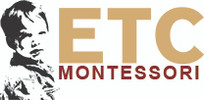
Creativity by definition, is the use of one’s imagination in the production of artistic work, or the use of imagination to promote innovative problem-solving skills. Although the Montessori method allows for creativity, it is important that we engage current brain research to encourage children to explore and uncover their own voice in developing creative expression.
Montessori believed that nature was the source of creativity. The beauty that could be found in it was the ultimate source of endless inspiration and creative thought for children. Yet, I don’t know that she would hold this same view if she was writing and working today. To fully understand her point of view, we need to take a brief look at the environment she was functioning in at that time. Art, at the time of Maria Montessori, was viewed as offensive. Therefore, in an effort to mirror that period's sentiment, Montessori embraced the traditional approach which was to draw inspiration from nature. As a devout Catholic, Montessori believed that any deviation from reality would be considered a sin. Therefore, she did not encourage creative or abstract artwork by the children. Instead, she encouraged creative artwork that was inspired by nature. “We do not give lessons in drawing and modeling, and yet many of our children know how to draw flowers, birds, landscapes, and even imaginary scenes in an admirable way” (Montessori, 1978, p. 280). With today’s view of art as well as the use of innovative techniques to solve many of our technological problems, I believe Maria Montessori might have a different view of how children would express creativity today.
By its very nature, the Montessori environment is designed to promote creative thinking and more importantly, creative problem solving. While children are allowed to explore, discover, and self-correct, there are certain steps that we can follow to ensure that creativity, and the art of creativity, is further encouraged and promoted.
Eliminate anxiety through a prepared environment
Make students feel safe and in charge of their potential. Allow them to take ownership of their work and the creative process that goes into their work. Communicate effectively and clearly with your students so they have a clear understanding of what is expected and what the final goal will be.
Share creative work through exploration
Provide your students with examples that are similar to their choice of projects. Examples should model creativity, self-sufficiency, and self-expression. Set quality and creativity as your goal not the amount of content.
Identify the learning style and allow for discovery
According to many neuro-educators, there are usually seven learning styles that students employ when it comes to learning. Although it is accepted that most of us use a variety or a combination of learning styles, it is important that we recognize the learning styles that our students prefer and allow them to make use of them. These seven learning styles are as follows:
- kinesthetic or physical (learn by movement)
- Visual or spatial (learn by visual stimuli such as pictures)
- auditory (learn through listening)
- verbal or linguistic (learn using words, either spoken or written)
- logical or mathematical (learn using logical patterns, or reasoning)
- social or interpersonal (learn by participating in group activities), and finally,
- solitary or intrapersonal (learn alone in a solitary manner).
Allowing your students to use their preferred method of learning will give them the freedom to be more creative not only in the absorption of knowledge but also in the expression of their work.
Voice their Choice
Allow students to voice their choice in how they will demonstrate mastery of a concept. Give them the ability to decide how they will complete the goal that they have been assigned.

